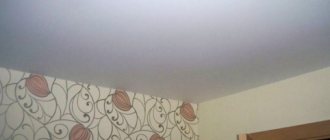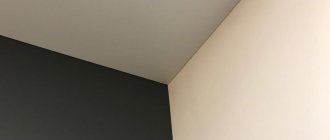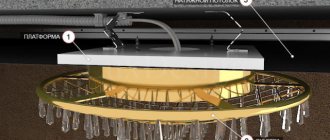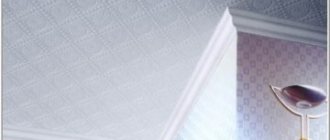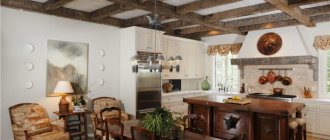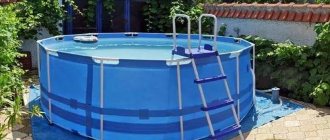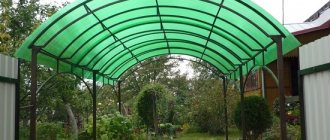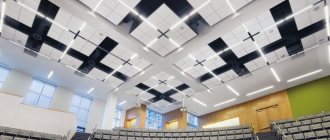So, the new glossy ceiling sparkles in the rays of the setting sun. The installers have left, the garbage has been removed... But what is this gap between the ceiling surface and the wall? Oh yes, after wallpapering, masking tape for suspended ceilings should be inserted there. Should I stick with it or prefer a ceiling plinth?
Let's find out more about this inconspicuous-looking plastic profile.
Is it necessary?
The answer to the question of whether a plinth is needed depends on the type of ceiling installed.
If we are talking about PVC film, then yes, a baguette is necessary. Because such fabrics are stretched in three ways: harpoon, wedge and glazing bead.
In all cases, a gap of about 0.5 cm is formed along the perimeter between the wall and the film. This looks unaesthetic, so it is covered with a plinth or a special decorative insert.
If we are talking about fabric stretch ceilings, then they are inserted into a special clothespin profile. In this case, there are no gaps left, and there is no urgent need for a plinth. If desired, you can not install it.
Installation
To perform the installation you will need a knife, a construction tape, a miter box, a spatula, a cord, and a pencil. Before installation, the profile is painted with special acrylic compounds, which are quick-drying and non-hazardous. To protect the wall from unexpected contamination, it can be covered with polyethylene or construction tape. Ceiling borders can only be attached to walls or frames. Sometimes liquid nails are used for this; they are suitable for any baseboards.
How to glue skirting boards to a PVC stretch ceiling? Process:
- Cut a piece of the plank to the desired size and form an angle. Do not cut the protrusion with an eye - this will create huge gaps at the joints, so always use a miter box.
- The affected area is cleaned, marked and primed.
- The adhesive composition is applied to the back side of the decorative strip. Carefully read the instructions for the selected adhesive. Some compounds need to be allowed to dry for a few minutes, others can be pressed on straight away.
- The plinth is glued from one corner by lightly pressing the edges against the walls. If curtains are placed between the wall and the ceiling, then in some areas you need to attach the slats at a short distance from the wall.
- The joint gaps are masked with putty.
- Excess glue squeezed out from vertical joints is immediately removed with a clean cloth.
- After which the backlight is installed, if necessary.
A stressed ceiling sheet is often subject to natural deformation, since the ambient temperature is not always constant. Never glue ceiling decor to the stretch fabric. Attaching to the fabric itself can disrupt the shape of the fabric and often leads to the appearance of glue droplets.
How is it different from usual?
You cannot glue anything to a thin fabric. Therefore, the plinth for a stretch ceiling should be quite light, because it will only be attached to the wall.
It is also worth paying attention to the shape. It should be such that the wider part is adjacent to the wall. This way the fixation will be more reliable.
One more nuance needs to be taken into account; many people confuse a regular baseboard with a camouflage insert. And these are two completely different things.
Regular moldings can be used with any ceiling, and inserts can only be used with a tension ceiling. They have a special T-shape to be inserted into the profile groove on which the blade is held.
PVC ceiling curbs
PVC trim strips are available in a variety of beautiful colors and designs and are inexpensive. Strong and durable, they are not flammable, are not affected by putrefactive bacteria, and can imitate stone, plaster, wood or other materials. Experts suggest using this option when decorating a ceiling with a square or rectangular configuration, which is due to low flexibility.
Pros:
- lungs;
- durable;
- abundance of colors and textures;
- low cost.
Minuses:
- turns yellow quickly;
- does not bend well;
- For cutting you need to use a hacksaw.
Some variations of plastic fillets have detachable connections, this allows them to be fixed in a hidden way using self-tapping screws. If significant defects occur, it is possible to replace one of the profiles with a new one.
Skirting or insert?
Both options are acceptable. It cannot be said that a plinth is better than an insert or vice versa. You need to proceed from the specific situation and the overall interior design.
So, for multi-level ceilings it is better to use an insert. It will make the finished composition more neat and concise.
If the walls are not perfectly smooth, you should opt for a plinth. It will smooth out the contrast between the absolutely smooth canvas and crooked supports.
The more unevenness there is on the walls, the wider the baguette you need to choose.
In this case, the plinth can be used usefully. For example, hide a curtain rod behind it, as shown in the photo below.
In some cases, both edging options are used. Most often, this solution is used when organizing lighting: the insert is placed around the perimeter of the canvas, and the plinth is lowered 5–10 cm below - then an LED strip is laid on it.
Each option has approximately an equal number of advantages and disadvantages.
| Skirting | Insert | ||
| pros | Minuses | pros | Minuses |
| Helps organize lighting | The panel may be damaged during installation. | Quick and easy installation | Occasionally falls out of the groove |
| Smoothes out uneven walls | Beautiful baguette models are more expensive than inserts | Emphasizes the curvature of walls | Doesn't always match the ceiling |
| Wide selection of materials and designs | Not suitable for multi-level ceilings | If necessary, it can be easily replaced with a new one | May change color over time |
| Self-installation is not always possible | Has a standard design | ||
| It is often impossible (or very difficult) to change | |||
Purpose and properties of the camouflage strip
The insert will hide all the irregularities
Despite the fact that finishing ceilings with PVC tape is a relatively new type of construction work, considerable experience has been accumulated in this type of activity.
Attention. Attempts to seal the gaps between the tensile structure and the wall with ceiling plinths, as a rule, ended in damage to the PVC sheet
Its surface became uneven, the glue dissolved it, and dismantling became impossible.
The solution to the situation was a plug for suspended ceilings. What is she? This is a profile made of flexible and soft plastic. It has a special comb for attaching to a mounting baguette. A soft longitudinal strip is attached to the ridge, covering all the smallest gaps between the film and the wall.
The camouflage plug for curtain coverings has a lot of positive properties.
So, its undoubted advantages include the following:
- a soft strip covers large and small irregularities, not only on a flat wall, but also on tiled walls;
- the flexibility of the material makes it possible to use it on curved surfaces;
- the rich color range of products allows them to be used not only for sealing joints, but also as a decorative element for single-level and multi-level surfaces;
- tape for hanging canvases looks great at the junction of two canvases in a connecting baguette;
- the elasticity of the material ensures tight fastening of the tape in the baguette; over time, the shape of the ridge and strip does not change;
- the product is reusable and can be used repeatedly if the structure is dismantled;
- the material is resistant to many substances and can be painted with almost any paint;
- to attach the strip to the ceiling, no special tools or glue are required - it can be easily inserted by hand;
- the product is durable, the material does not rot, does not fade or dry out;
- affordable price does not significantly affect the repair budget;
- The insert is stored in rolls and sold by the meter, which avoids joints during installation.
Different types of this material allow it to be used for specific purposes.
Kinds
In addition to this appearance, moldings are divided by materials and sizes (width).
Material
Modern industry offers a variety of skirting board options. But not all varieties are suitable for NP.
First of all, you need to abandon massive moldings made of heavy materials (for example, plaster). You can replace voluminous stucco with lighter analogues. The appearance will remain virtually unchanged, but the load on the wall will not be so great.
It is also worth paying attention to the shape of the room. For curvilinearities, it is better to choose more flexible materials. And with an abundance of corners in the room, you should opt for materials that are easy to cut and do not crumble.
Below is a list of the most suitable options, indicating the advantages and disadvantages of each variety.
Polyurethane
Polyurethane is one of the most popular materials for fillets. The assortment of construction stores will allow you to choose a model for any interior.
As for the color palette, everything is simple. This polymer can be easily painted in any shade. If desired, it can be given various effects: antique, etc.
Polyurethane skirting boards can be divided into three types.
With imitation stucco.
Such cornices have a rich finish and successfully replace heavy plaster. In addition, there are other decorative elements with the same pattern: columns, fireplace decorations, etc. This allows you to decorate the room in a single style.
Flexible baseboard.
It cannot be said that this type of polyurethane is frankly soft, but it bends easily, allowing you to create rounded shapes and various curves. A round or slanting ceiling will not be a problem for such a fillet.
With a niche for lighting.
Almost all types of polyurethane skirting boards have a special groove for wires. But often it is hidden in the center of the cornice. But there is a separate type of moldings with an open niche on top. It perfectly includes a diode strip when organizing the backlight.
The main disadvantage of polyurethane is its price. The cost per linear meter can reach several thousand.
But these costs are justified. The polymer is incredibly durable. It can easily withstand temperature changes, which allows it to be used not only in residential apartments, but also in unheated cottages.
Another disadvantage of polyurethane: it can shrink. One-time, insignificant, but in some cases this is enough for the seams to come apart and unsightly gaps remain between them.
Wood
Once upon a time this material was the only possible one, but now wood is used extremely rarely. Yes, this material is more natural, but its price and difficulties in care and installation scare off ordinary people.
Rubber
Customers often puzzle workers at hardware stores by asking them for rubber skirting boards for suspended ceilings. There are no such elements. An insert is made from rubber, which ordinary people confuse with a classic fillet.
This also includes frequent questions on forums, such as: how to insert a skirting board into a suspended ceiling, etc. You can only fill the insert; the cornices are glued.
PVC
Initially, polyvinyl chloride baguettes were created specifically for PVC panels. And the first models of such skirting boards had a special groove into which these same panels were inserted.
But the material turned out to be so successful that they first began to insert MDF panels into the groove, and then the range was expanded and began to be used for all types of ceilings.
The demand for PVC is due to one thing - simple installation. When installing it yourself, the main difficulties are caused by gluing the corners (especially on wide baseboards). PVC fillets eliminate this problem, as they are assembled like a construction set. True, not everyone likes the look of the connecting elements.
Duropolymer
Duropolymer is a Belgian material based on polystyrene foam.
The list of advantages includes significant strength, almost anti-vandalism.
The disadvantages of duropolymer ceiling plinths include a relatively small selection of models. Patterned stucco and graceful lines are not to be found here.
In addition, duropolymer cornices are quite massive. This polymer is of course lighter than gypsum, but bulk molding will weigh quite a bit. Such elements often require fixing not only to the wall, but also to the ceiling. But in the case of a stretched fabric, this is impossible.
Otherwise, this polymer is somewhat reminiscent of polyurethane. It can also be painted, it can be used to organize lighting, but it is not so flexible. But it costs about thirty percent less.
Styrofoam
Foam moldings are the lightest and most inexpensive. But this material cannot be considered durable and reliable.
The choice of foam models is very large, but due to the structure of the material, joints and corners may not be very neat.
It is better not to leave foam baseboards in their original white color. Over time, this material turns yellow.
Size
The length of the baguette does not really matter. All products are perfectly cut to the desired size of the room. You need to pay attention to the width.
Narrow
A narrow plinth (from 1 to 5 cm) is used in three cases:
- for improving multi-level ceilings;
- with perfectly smooth walls;
- if the room has a low ceiling height (in Khrushchev buildings, etc.).
But there are options when the room has a small height, but the walls are uneven. In this case, a wide baguette will look tacky, and a narrow one will emphasize unevenness.
To hide defects, you can use a little trick - hide the corners of the room. It is at the joints that the curvature is most noticeable.
By hiding corners behind curtains, tall cabinets, or voluminous plants, you can visually “align the walls.”
In tandem with this decor, you can use a narrow molding.
Average
Medium width skirting boards are the most versatile. Each manufacturer has similar models, which allows you to choose an interesting option for any room. 5–15 cm - this is the width range that is best suited for rooms with a height of 2.5–3 m.
Fillets for hidden lighting are available in this size, which allows you to decorate ceilings without “stealing” precious centimeters.
Wide
Moldings 16–35 cm wide are suitable only for large rooms with a ceiling height of at least 3 m. For such large structures, you need to pay attention to the weight of the products. Due to the impossibility of attaching to the canvas, not all models can be used.
Varieties
Decorative camouflage inserts that are used in the repair process can be different. They allow you to work with ceilings of various configurations and get results that satisfy your expectations every time.
T-shaped
They are made from polyvinyl chloride. This is a hard material that is advantageous to use on surfaces lined with porcelain stoneware or regular tiles. Due to their strength and reliability, they are used to cover gaps between the ceiling and the wall.
L-shaped
This option is also called wall corners. They are quite elastic, like rubber, and, as a rule, are used to mask some really problem areas. For example, too uneven surfaces or deep gaps.
They are also used in corners where it can be so difficult to reach.
F-tapes
These inserts are attached in such a way as to cover not only the gap between the wall and the suspended ceiling, but also the space of the profile not covered by the canvas. It is convenient and aesthetically pleasing.
The upper part of such a plug rests against the base of the wall, and the insert is attached to the profile using special “antennae”. This tape is quite wide, so when choosing it, you should look for some beautiful option that will well complement the creative idea embodied in the chosen room.
Separately, it is worth noting that, despite minor differences, these types of masking tapes are not particularly different. The installation process is the same here. To fix the tapes, simply press them into the groove, applying very little force.
If something goes wrong and some error occurs during the fastening process, you can easily remove the part and insert it back.
In addition, it will be possible to remove it after the ceiling is dismantled. For example, if there are problems with the wiring, the ceiling decorative tape can be reused when installing a new ceiling.
How to decorate a ceiling with skirting boards
There is no perfect design option. Almost any fantasy can be brought to life. The main thing is that the chosen molding matches the specific interior.
It is also worth considering the features of the room. It will be difficult to install a hard plinth on a slanted stretch ceiling, and a multi-tiered canvas will not be combined with a wide fillet.
LED strip lighting
One of the most popular design options is canvas illumination (what it looks like is shown in the photo below).
This decoration is easy to install and at the same time visually raises the ceilings.
There are many types of lighting, but the most popular type is LED strip. It “steals” the minimum height, does not heat up and uses electricity sparingly.
Most manufacturers produce special skirting boards with a recess for LED strips. Depending on the location of the slot, the light can go both along the canvas and along the wall.
Such moldings are attached in the same way. But some models need to be installed just below the PVC ceiling (5–15 cm), which in tandem with the light creates a “floating” effect.
The most difficult thing in this decor is to do the wiring correctly. Then all that remains is to enjoy the beautiful effect.
Multi-tiered
For high-tech design, the baseboard can be successfully replaced with a soft insert. But this solution is completely unsuitable for classic interiors. In such rooms, plinth is vital.
But when designing multi-tiered ceilings, you need to take into account the height of the room. In order for the room to look harmonious, each tier must be wide enough (at least 10 cm).
Not every room can safely withstand such a loss of height. To prevent the room from looking disproportionate, the original ceiling height should be more than 3.2 m.
But the spacious halls allow you to play with space in an unconventional way.
Options for profiles of applied masking edges
Tape material for finishing the edges of suspended ceilings is made in the form of several basic profiles. The most common ones look like this:
- Universal masking tape with L-shaped section. Can be installed on almost any load-bearing profiles of suspended ceilings;
- A tape plug with an F-shaped section is essentially the same L-shaped profile, but in a reinforced form, since the adhesion area of the protrusion of the masking tape to the load-bearing ceiling profile is doubled;
- Masking tape with a profile in the shape of the letter “T”. The most rigid and durable option, used, as a rule, on walls made of plasterboard or tiled.
Most of the masking tapes on the market are produced by manufacturers of ceiling fittings and suspended ceilings. If you order the installation of a ceiling sheet from a well-known construction company, then, most likely, the quality of the masking tapes will be as high as the ceilings themselves or the mounting profile.
For your information! Installation of masking tape is easiest to do on aluminum ceiling profiles.
The services of professionals in installing suspended PVC ceiling membranes are always expensive, so customers often try to save money on simple operations, for example, installing masking tape for suspended ceilings with their own hands. This is truly a simple operation that is accessible to almost everyone. You can try your hand at installing masking tape on a suspended ceiling using the video
The most popular is white masking tape; its price varies depending on demand and the manufacturer, but on average it is 8-20 rubles. per linear meter for a white insert, and 20-50 for a colored one. Craftsmen charge ten times more for installing tape, and 180 rubles for color tape. and for white 80-85 rubles. per meter
Masking tape against ceiling plinth
The main purpose for which decorative tape is installed for suspended ceilings is to hide the gap at the wall that is untidy to the eye. However, you know another method to mask all the flaws in a given junction of the ceiling and walls - ceiling plinth. Of course, if you choose it, you should familiarize yourself with the features of its installation:
- Skirting boards are mounted only to walls. You cannot glue them directly to a stretch ceiling: the canvas will move in waves, and drafts that vibrate the ceiling film will loosen the adhesive seams of the baseboards. In addition, it is not known in advance how the thinnest film will react to the composition of the adhesive.
- It is recommended to choose ceiling plinths for stickers to the wall with the maximum width of the area. The reason has already been mentioned: the skirting boards will have to be glued exclusively to one surface.
- If you choose a wide molding instead of a baseboard, then problems with the sticker will be minimized, because initially the molding is intended to be attached exclusively to the wall.
Ceiling plinths go well with stretch fabric. But their installation is quite specific. And masking tape has one big advantage over ceiling plinths: decorative tape for suspended ceilings can be installed reversibly. There are not as few situations when you have to dismantle a suspended ceiling as it might seem at first glance.
The list of reasons for dismantling the tension fabric includes faulty hidden communications, necessary replacement of pipes, flooding by neighbors above, short circuits and other wiring problems. In short, sooner or later the ceiling has to be removed and reinstalled. Harpoon technology for attaching PVC film allows you to do this quickly and without any problems. The masking tape for the ceiling can be easily pulled out of the profile and inserted back into place.
https://youtube.com/watch?v=vp27_1y4srk
But glued baseboards have a significant drawback against this background: when dismantling, they will have to be torn off and simply thrown away, and the area under the sticker will no longer be smooth. The tape is much narrower than the ceiling plinth. Even if you choose a contrasting color, the tape will slightly reduce the visible area of the ceiling. But a person estimates the size of a room by the area of the ceiling and floor.
What can be glued instead
There are quite a lot of analogues to the classic plinth. The only thing that all these “substitutes” have in common is their small width. Therefore, they are used only in rooms with smooth walls.
Rope, rope
Most often, “rope plinth” means a regular curtain cord. Depending on the thickness, it can either be inserted into the groove of an aluminum profile, or glued to the wall using the same liquid nails.
The first option is simpler, but in this case the rope may fall out over time.
Gluing the cord is a little more difficult, but it will hold more securely.
The disadvantage of this material is that it is rarely one color. Very often it is complemented by shiny lurex or contrasting colors. This design looks very impressive, but many people do not like the excessive brightness of the edging. After all, it emphasizes any unevenness.
Insert (tape)
The rubber insert is a special tape that was invented by ceiling manufacturers. But this rubber instead of skirting boards is only suitable for perfectly smooth walls.
Wallpaper panel
This option is a little outdated, but some people use it because of the low cost of registration. The panel cannot be considered a full replacement for the molding; rather, it is an addition to a ceiling insert or cord that is too thin.
Frieze (border)
For bathrooms, an analogue of the panel is a frieze - a contrasting border made of tiles. It is also used in tandem with a cord or insert, which visually expands the “plinth”.
Quality characteristics of masking tape
Designed to provide a finishing touch, masking tape for stretch ceilings is a narrow and soft profile. It is made, like the canvas itself, from PVC material. The texture of the material is very flexible, so it is easy to bend, but it will not break or deform, which makes it possible to use it on the most curved structures. Installers also call masking tape a plug for suspended ceilings.
The plug for suspended ceilings has many positive qualities, among them:
the ability to hide the gap along the wall that remains after the suspended ceiling is completely installed; flexibility and plasticity will allow you to design any rounded corners of the room; in large spacious rooms where the ceiling area is large, it is used as a connection between two canvases; selected in different colors, can serve as decoration for a multi-level structure; thanks to a fairly wide range of colors, it can be matched to any type and shade of coating, while the correct choice of color scheme will help it be organic, invisible or, conversely, brightly frame the perimeter of the ceiling; the properties of the manufacturing material do not allow it to deform regardless of its service life; in case of ceiling replacement, can be reused; the material is resistant to various chemicals, so glue or paint will not have any destructive effect; ease of installation does not require special knowledge and skills, only some effort is required; due to the strength of the material, it does not deteriorate during operation and does not lose its qualities; It can be purchased by footage of any length, which allows you to minimize the number of joints; in small rooms, the advantage of such a device is that it does not take up extra space, unlike ceiling plinths; prevents the accumulation of dust that could get into the gap near the wall; An important advantage is the relatively low price. Masking tape also has some disadvantages, mainly related to interior design:
Masking tape also has some disadvantages, mainly related to interior design:
- firstly, it will not be able to hide very obvious defects and unevenness of the walls at the ceiling level;
- secondly, when using tape it is not possible to install lighting, therefore, if the need arises, the problem can be solved with the help of a special ceiling cornice.
Recommendations for choosing color and texture
Manufacturers of masking tapes offer a sufficient selection of colors and textures.
The main types of invoices include:
- Glossy masking tapes serve mainly as decoration for glossy canvases. They perfectly reflect light, which is advantageously used in combination with selected lighting when decorating interiors.
- The matte texture will serve as an excellent continuation for stretched matte canvases.
- Patterns and embossing make it an additional decorative element for decorating the interior style of the room.
Great importance for maintaining the interior style is given to the color of the tape used, for example:
- a plug of one tone with a suspended ceiling contributes to the visual expansion of the room, a contrasting shade, on the contrary, will make the room narrower;
- if you take a tape that matches the tone of the walls, the walls will appear higher than they actually are;
- contrasting shades of the plug will draw a clear line between the ceiling surface and the walls, which, in this case, must be perfectly smooth, because otherwise, the contrast will only draw attention to unevenness;
- An interesting option for combining the color of the ribbon with the color of furniture or other interior decoration elements.
You can paint the tape yourself with any acrylic paint, but this must be done before installing it.
Thanks to the wide range of colors, it can easily be matched to a wide variety of stretch fabrics. A variety of shades, ranging from white to black, are used for both matte and glossy and patterned masking tapes.
Modern ceiling design involves not just colored canvases, but the use of color photo printing, which makes the interior very individual and especially beautiful, and masking tape will only enhance this effect.
Bottom line
Modern ceiling technologies do not stand still, and ceiling fastening systems have long appeared that do not require decorative plugs. This is a shadow profile, and the Stock system, and Lumpher came up with something of his own. But all these new technologies are noticeably more expensive, and therefore the classic elastic band will be in demand for a very long time.
Use only good tape that is easy to install, do not save these 1-2 rubles per meter. Use special tools for installation: various inserters, rollers, corner scissors for PVC. Measure the room using a laser tape measure.
Share with friends:
